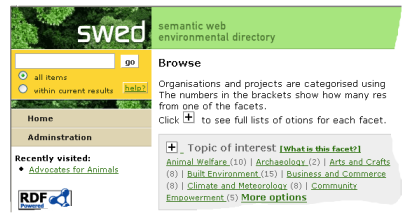
The Semantic Web Environment Directory (SWED) project is a SWAD-E demonstrator aimed at illustrating the nature of the semantic web and the practical issues in making use of it.
The focus of the demonstration is to create a directory of UK based environmental organisations. The SWED team are working closely with the The Environment Council and other environmental, natural history and community organisations, to help ensure that the directory will meet the needs of the wider environment related community in the UK.
The key outputs of the project are:
All data and software are being developed using non-proprietary open technical standards.
Key goals of the project include:
These goals are made possible by using a Semantic Web based approach. This approach means that the directory member organisations publish, own and control their own information. This information is then harvested and collated by SWED who produce a directory Web site.
Essentially the SWED directory provides a view of the data, that is brought together from across the Web. This 'self publishing' or data harvesting approach means that others can also harvest and collate the information and provide different views (e.g. a specialist directory containing only a small subset of the organisations) and enrich the information by adding their own additional information (e.g. what specialist services or resources organisations provide).
On the Web site, the richness of the indexing of the information makes it easy to browse and search, to find relevant organisations.
While SWED is a research project we are working with a number of national and local environmental organisations to develop an exit strategy that will help ensure that the system is used and maintained once the project ends.
The demonstrator illustrates many practical features of the semantic web.
The RDF data format is used for publication of the organization descriptions. As well as capturing basic properties such as name and description this enables us to capture classifications for organizations and relational links between them. The decentralized nature of the approach means that a subgroup in the community would be free to enrich their descriptions with other information or to publish additional annotations on existing published descriptions using new or extended vocabularies. This is illustrated in the web site in that the bootstrap organization descriptions are taken from an earlier publication and augmented by classifications and relational links published directly by the SWED team. The site's user interface makes it clear when a page is displaying information from such mixed sources and makes it possible to trace back the provenance of the information.
The vocabularies used to organize the data into different topic hierarchies are published as a mixture of OWL ontologies and SKOS thesauri. This illustrates the ability to mix and match different vocabulary schemes and the interface itself illustrates the benefits of using such schemes in enabling browsing.
Thus this demonstrator reinforces the three main components of the semantic web: data + ontologies + webness.